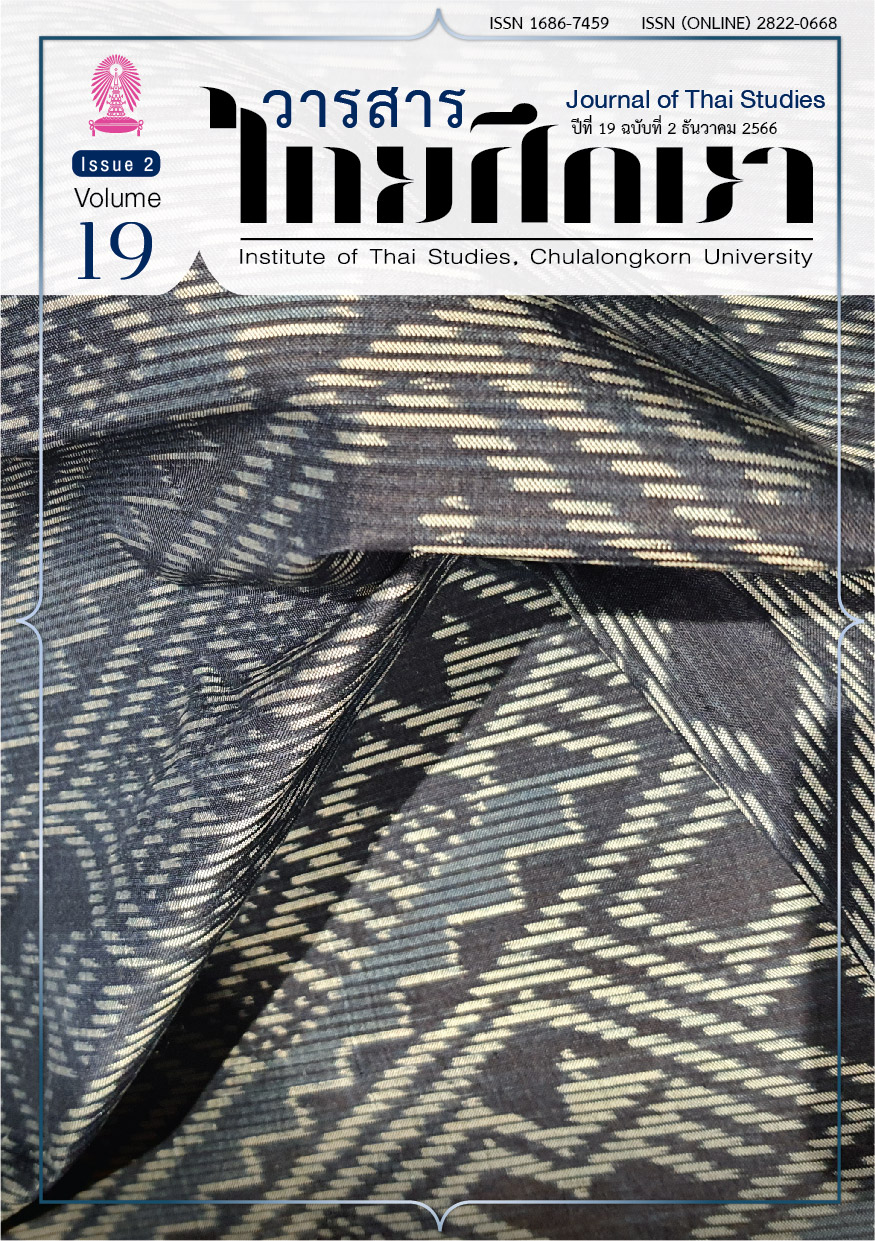Traces of Burmese language in The Rama tale of Tai Yai (Chao Rama)
Main Article Content
Abstract
Background and objective (s):
There is clear evidence that The Shan and the Burmese kingdoms have been connected in historical and political dimensions for a long time. However, there is scarce evidence of the connection between the two in terms of linguistic and literary dimensions. The Rama tale of the Shan (Chao Rama) is a Shan version of the story of Rama that indicates the connection between the two kingdoms in terms of language. This article aims to point out the influence of the Burmese language on Shan literature by studying the traces of the script and Burmese orthography, including the characteristics of loan words that appear in the Chao Rama story.
Methodology:
Analysis of the alphabet used, orthography and loanwords in the literature.
Main result:
Pali verse and Burmese words are frequently written using the Burmese alphabet and orthography. In terms of alphabet and orthography, the results demonstrated that this Shan (Tai Yai) literature employs both Burmese and Pali loanwords, in addition to Pali loanwords using the Shan alphabet and Burmese orthography.
The use of Burmese words in this literature suggests that the Shan may have adopted various Burmese words from the Bagan period to the present. The spelling and pronunciation of Burmese loanwords in the Shan language are distinct. Furthermore, it was found that the fonts have been modified to correspond with the pronunciation in the Shan language. Finally, similar to Pali loanwords in Burmese, the Shan Pali loanwords are pronounced with consonant spellings and the addition of tonal sounds based on the sound characteristics of the Burmese language.
Relevance to Thai Studies:
This article aims to expand the knowledge of Tai Studies, especially the relationship between Shan and Burmese language and literature. This study shows that the Burmese language has influenced the Shan language. This article will serve as the starting point for a further comparative study of the Burmese, Thai and Shan Rama stories.
Conclusion:
Burmese language traces found in the Shan Rama story indicate a relationship between the Shan and Burma languages and cultures. The Shan poets used Burmese loan words to compose their works, modifying the sound following the characteristics of the Shan language. Therefore, this combination of the Shan and Burmese languages also reflects the linguistic prowess of the Shan poets.
Downloads
Article Details

This work is licensed under a Creative Commons Attribution-NonCommercial-NoDerivatives 4.0 International License.
Journal of Thai studies is licensed under a Creative Commons Attribution-Noncommercial-NoDerivatives4.0 Intenational (CC BY-NC-ND 4.0) licence, unless otherwise stated. Plese read our Policies page for more information on Open Access, copyright and permissions.
References
Aggasena, N. Phra. (2021). “An Analytical Study of Burmese Loanwords in Shan Language”. Academic MCU Buriram Journal 6 (2), p. 144-157.
Bandhumedha, B. (1979). Pai Sob Kham Thai [Thai Word Analysis]. Bangkok: Ministry of Education.
Brockington, J. L. (1985). Righteous Rama: The Evolution of an Epic. Delhi: Oxford University Press.
Cao Rama. Parabaik Microfilm No. มส 07 21 022 00 From Digital Library of Northern Thai Manuscripts.
Cochrane, W.W. (1910). Shans at Home. London: Hazell, Watson and Viney, Ld.
Coedes, G. (1925). Tamnan Akson Thai [The History of Thai scripts]. memorial book in Royal
Cremation Ceremony Mrs. Yiam leksuphap at Army Crematory, Sommanas Wihan Temple on December 2, 2000.
Cushing, J.N. (1914). Shan and English Dictionary. Rangoon: American Baptist Mission Press.
DrDearInstitute. (2018). “botrian thi 1: phayanchana sara wannayuk phasa phama” [Chapter 1: consonants vowels and tones of Burmese]. [webblog]. Retrieved from http://drdearinstitute.blogspot.com/2018/03/1_19.html
Khanthaphad, P. (2017). “Pali-Sanskrit Borrowings in the Shan Language”. Silpakorn University Journal, 39(3), 177-196.
Khanthaphad, P. (2019). “Burmese Borrowings in the Shan Language”. Silpakorn University Journal, 39(3), 119-132.
Limpisiri, T., Naksuk, Y. and Akwareesakul, A. (2018). “The Proposed Guidance for Tonal Transcription from Burmese to Thai: An Acoustic-phonetic Comparative Study”. Humanities & Social Sciences, 35(1), 117-140.
Maung khin Min. (2012). Myanmar Saka Myanmar Yout Pong Hlwa [Burmese language,Burmese pictures]. Nay Pyi Taw: Department of Burmese Literature. [Burmese]
Nandiya, N. (2018). A Phonological Study of Tai Yai Dialect Spoken at Piang Luang Village Wiang Haeng District Chiang Mai Province. (Master's thesis). Mahachulalongkorn rajavidyalay University, Phra Nakhon Si Ayutthaya, Thailand.
Puntumin, U. (2017). Kham Man – Kham Mueang [Burmese word – Lanna word]. Chiang Mai: Myanmar Center, Faculty of Humanities, Chiang Mai University.
Sai Kham Mong. (2004). The History and Development of The Shan Scripts. Chiang Mai: Silkworm Books.
Social Research Institute. (2008). Thai Yai Khwam Pen Yai Nai Chatphan [Tai Yai, the Great Tai in Ethnics]. Chiang Mai: Social Research Institute.
Toru, O. (2000). Burmese Ramayana. Delhi: Praja offset.
Toru, O. (2005). “The structure of Pagan period Burmese”. Studies in Burmese linguistics. The Australian National University. Research School of Pacific and Asian Studies. Pacific Linguistics, 241-331.
U Thein Han and U Khin Zaw. (1989). “Ramayana in Burmese Literature and Arts”. The Ramayana Tradition in Asia. New Delhi: Sahitya Akademi.
Wichasin, R. (2004). Phasa Thaiya [Tai Yai Language]. Chiang Mai: Thai Department, Faculty of Humanities, Chiang Mai University.


